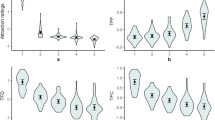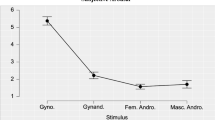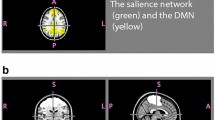Abstract
Transsexualism is characterized by feelings of incongruity between one’s natal sex and one’s gender identity. It is unclear whether transsexual individuals have a body image that is more congruent with their gender identity than their sex assigned at birth (natal sex) and, if so, whether there are contributions from perceptual dysfunctions. We compared 16 pre-hormone treatment female-to-male transsexual (FtM) individuals to 20 heterosexual female and 20 heterosexual male controls on a visual identification task. Participants viewed photographs of their own body that were morphed by different degrees to bodies of other females or males, and were instructed to rate “To what degree is this picture you?” We also tested global vs. local visual processing using the inverted faces task. FtM differed from both control groups in demonstrating higher self-identification ratings for bodies morphed to the sex congruent with their gender identity, and across a broad range of morph percentages. This difference was more pronounced for longer viewing durations. FtM showed reduced accuracy for upright faces compared with female controls for short duration stimuli, but no advantage for inverted faces. These results suggest different own body identification in FtM, consisting of a relatively diffuse identification with body images congruent with their gender identity. This is more likely accounted for by conscious, cognitive factors than perceptual differences.




Similar content being viewed by others
References
American Psychiatric Association. (2013). Diagnostic and statistical manual of mental disorders (5th ed.). Washington, DC: Author.
Bandini, E., Fisher, A. D., Castellini, G., Lo Sauro, C., Lelli, L., Meriggiola, M. C., & Ricca, V. (2013). Gender identity disorder and eating disorders: Similarities and differences in terms of body uneasiness. Journal of Sexual Medicine, 10, 1012–1023.
Cash, T. F., & Deagle, E. A, 3rd. (1997). The nature and extent of body-image disturbances in anorexia nervosa and bulimia nervosa: A meta-analysis. International Journal of Eating Disorders, 22, 107–125.
Cash, T. F., & Pruzinsky, T. (2002). Body image: A handbook of theory, research, and clinical practice. New York: Guilford Press.
Cohen-Kettenis, P. T., & Pfafflin, F. (2010). The DSM diagnostic criteria for gender identity disorder in adolescents and adults. Archives of Sexual Behavior, 39, 499–513.
Coleman, E., Bockting, W., Botzer, M., Cohen-Kettenis, P., DeCuypere, G., Feldman, J., … Zucker, K. (2012). Standards of care for the health of transsexual, transgender, and gender-nonconforming people, Version 7. International Journal of Transgenderism, 13, 165–232.
Constantino, J. N., & Gruber, C. P. (2005). Social responsiveness scale. Los Angeles: Western Psychological Services.
Costantini, M., Urgesi, C., Galati, G., Romani, G. L., & Aglioti, S. M. (2011). Haptic perception and body representation in lateral and medial occipito-temporal cortices. Neuropsychologia, 49, 821–829.
Downing, P. E., Jiang, Y. H., Shuman, M., & Kanwisher, N. (2001). A cortical area selective for visual processing of the human body. Science, 293, 2470–2473.
Farah, M. J., Tanaka, J. W., & Drain, H. M. (1995). What causes the face inversion effect? Journal of Experimental Psychology, 21, 628–634.
Feusner, J. D., Hembacher, E., Moller, H., & Moody, T. D. (2011). Abnormalities of object visual processing in body dysmorphic disorder. Psychological Medicine, 18, 2385–2397.
Feusner, J. D., Moller, H., Altstein, L., Sugar, C., Bookheimer, S., Yoon, J., & Hembacher, E. (2010a). Inverted face processing in body dysmorphic disorder. Journal of Psychiatric Research, 44, 1088–1094.
Feusner, J. D., Moody, T., Townsend, J., McKinley, M., Hembacher, E., Moller, H., & Bookheimer, S. (2010b). Abnormalities of visual processing and frontostriatal systems in body dysmorphic disorder. Archives of General Psychiatry, 67, 197–205.
Feusner, J. D., Townsend, J., Bystritsky, A., & Bookheimer, S. (2007). Visual information processing of faces in body dysmorphic disorder. Archives of General Psychiatry, 64, 1417–1425.
Jefferies, K., Laws, K. R., & Fineberg, N. A. (2012). Superior face recognition in body dysmorphic disorder. Journal of Obsessive-Compulsive and Related Disorders, 1, 175–179.
Kinsey, A. C., Pomeroy, W. B., Martin, C. E., & Gebhard, P. H. (1953). Sexual behavior in the human female. Philadelphia: W. B. Saunders Co.
Kraemer, B., Delsignore, A., Schnyder, U., & Hepp, U. (2008). Body image and transsexualism. Psychopathology, 41, 96–100.
Leder, H., & Bruce, V. (2000). When inverted faces are recognized: The role of configural information in face recognition. Quarterly Journal of Experimental Psychology Section A: Human Experimental Psychology, 53, 513–536.
Lin, C. S., Ku, H. L., Chao, H. T., Tu, P. C., Li, C. T., Cheng, C. M., … Hsieh, J. C. (2014). Neural network of body representation differs between transsexuals and cissexuals. PLoS One, 9(1), e85914.
Longo, M. R., Azanon, E., & Haggard, P. (2010). More than skin deep: Body representation beyond primary somatosensory cortex. Neuropsychologia, 48, 655–668.
Luders, E., Sanchez, F. J., Gaser, C., Toga, A. W., Narr, K. L., Hamilton, L. S., & Vilain, E. (2009). Regional gray matter variation in male-to-female transsexualism. Neuroimage, 46, 904–907.
Mohr, H. M., Roder, C., Zimmermann, J., Hummel, D., Negele, A., & Grabhorn, R. (2011). Body image distortions in bulimia nervosa: Investigating body size overestimation and body size satisfaction by fMRI. Neuroimage, 56, 1822–1831.
Mundy, E. M., & Sadusky, A. (2014). Abnormalities in visual processing amongst students with body image concerns. Advances in Cognitive Psychology, 10, 39–48.
Overas, M., Kapstad, H., Brunborg, C., Landro, N. I., & Lask, B. (2014). Memory versus perception of body size in patients with anorexia nervosa and healthy controls. European Eating Disorders Review, 22, 109–115.
Peelen, M. V., & Downing, P. E. (2005). Within-subject reproducibility of category-specific visual activation with functional MRI. Human Brain Mapping, 25, 402–408.
Peelen, M. V., & Downing, P. E. (2007). The neural basis of visual body perception. Nature Reviews Neuroscience, 8, 636–648.
Reed, C. L., Stone, V. E., Grubb, J. D., & McGoldrick, J. E. (2006). Turning configural processing upside down: Part and whole body postures. Journal of Experimental Psychology-Human Perception and Performance, 32, 73–87.
Savic, I., & Arver, S. (2011). Sex dimorphism of the brain in male-to-female transsexuals. Cerebral Cortex, 21, 2525–2533.
Schwarzlose, R. F., Baker, C. I., & Kanwisher, N. (2005). Separate face and body selectivity on the fusiform gyrus. Journal of Neuroscience, 25, 11055–11059.
Sepulveda, A. R., Botella, J., & Leon, J. A. (2002). Body-image disturbance in eating disorders: A meta-analysis. Psychology in Spain, 6, 83–95.
Simon, L., Kozak, L. R., Simon, V., Czobor, P., Unoka, Z., Szabo, A., & Csukly, G. (2013). Regional grey matter structure differences between transsexuals and healthy controls: A voxel based morphometry study. PLoS One, 8(12), e83947.
Smeets, M. A., Ingleby, J. D., Hoek, H. W., & Panhuysen, G. E. (1999). Body size perception in anorexia nervosa: A signal detection approach. Journal of Psychosomatic Research, 46, 465–477.
Spangler, D. L., & Allen, M. D. (2012). An fMRI investigation of emotional processing of body shape in bulimia nervosa. International Journal of Eating Disorders, 45, 17–25.
Taylor, J. C., Wiggett, A. J., & Downing, P. E. (2010). fMRI-adaptation studies of viewpoint tuning in the extrastriate and fusiform body areas. Journal of Neurophysiology, 103, 1467–1477.
Urgesi, C., Berlucchi, G., & Aglioti, S. M. (2004). Magnetic stimulation of extrastriate body area impairs visual processing of nonfacial body parts. Current Biology, 14, 2130–2134.
Urgesi, C., Calvo-Merino, B., Haggard, P., & Aglioti, S. M. (2007). Transcranial magnetic stimulation reveals two cortical pathways for visual body processing. Journal of Neuroscience, 27, 8023–8030.
Urgesi, C., Candidi, M., Ionta, S., & Aglioti, S. M. (2007). Representation of body identity and body actions in extrastriate body area and ventral premotor cortex. Nature Neuroscience, 10, 30–31.
Urgesi, C., Fornasari, L., Canalaz, F., Perini, L., Cremaschi, S., Faleschini, L., … Brambilla, P. (2014). Impaired configural body processing in anorexia nervosa: Evidence from the body inversion effect. British Journal of Psychology, 105, 486–508.
Urgesi, C., Fornasari, L., Perini, L., Canalaz, F., Cremaschi, S., Faleschini, L., … Brambilla, P. (2012). Visual body perception in anorexia nervosa. International Journal of Eating Disorders, 45, 501–511.
Valentine, T. (1988). Upside-down faces: A review of the effect of inversion upon face recognition. British Journal of Psychology, 79, 471–491.
van den Eynde, F., Giampietro, V., Simmons, A., Uher, R., Andrew, C. M., Harvey, P. O., … Schmidt, U. (2013). Brain responses to body image stimuli but not food are altered in women with bulimia nervosa. BMC Psychiatry, 13(1), 302.
Yin, R. K. (1969). Looking at upside-down faces. Journal of Experimental Psychology, 81, 141–145.
Author information
Authors and Affiliations
Corresponding author
Ethics declarations
Conflict of interest
None.
Rights and permissions
About this article
Cite this article
Feusner, J.D., Dervisic, J., Kosidou, K. et al. Female-to-Male Transsexual Individuals Demonstrate Different Own Body Identification. Arch Sex Behav 45, 525–536 (2016). https://doi.org/10.1007/s10508-015-0596-z
Received:
Revised:
Accepted:
Published:
Issue Date:
DOI: https://doi.org/10.1007/s10508-015-0596-z




